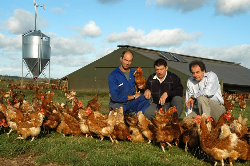
(for more Free Range stories visit www.theranger.co.uk)
The thorny issue of whether mobile hen houses require planning permission has resurfaced—and this time the man involved wants it sorting out once and for all.
Free range producer and designer of the Freedom Farm mobile hen house, Ken Ford, is being threatened with enforcement action over two buildings he positioned on his farm near Chulmleigh in Devon.
The first building, measuring 30 x 13 metres and housing 3000 hens, went up five years ago—without planning—and had managed to avoid the attention of Mr Ford's local authority, Mid-Devon District Council, until, that is, he put up a second building.
Mr Ford uses the farm as a demonstration unit and he believes this is an important aspect of Freedom Farm's marketing strategy.
"It is important for potential purchasers to see the houses in operation for themselves," he told the Ranger. "That way we are able to substantiate any claims we might make and it also enables full testing of any modifications."
Because the Freedom Farm buildings have undergone further development since the original design of five years ago, Mr Ford wanted to put a second 3000 bird unit on his 16 acre holding. But that's when he ran into trouble with the planners, for this time he decided to apply for planning permission but the application was subsequently turned down.
"The day my application was refused the same planning committee granted permission for an identical building we had sold to a customer," says Mr Ford. "There's just no consistency with the planners' approach."
The application was rejected on the grounds that the site lies within an area of great landscape value and the mobile hen house was considered unsightly.
But this didn't deter Mr Ford who went on to erect the building anyway, this time on the basis that the development should fall outside planning regulations because the building could be classed as mobile, despite its size. But unfortunately for him, his local authority did not agree and is now threatening him with an enforcement notice on both houses.
"I know my actions have stoked the fire somewhat but I believe it's time the uncertainty over the planning issue for mobiles was sorted out," says Mr Ford, although he doesn't expect his customers to get involved in similar wrangles.
The company has now sold over fifty buildings, sited on farms all over the UK, including four to the John Lewis estate in Hampshire which produces eggs for Waitrose.
"We have always recommended customers contact their local planning department before siting the buildings as I don't think it is reasonable to expect them, having made such a large investment, to cope with the uncertainty I now find myself under.
"But the response from different councils varies tremendously. Some insist on full planning while others take the view that they are mobile structures and fall outside the rules. That's what makes the situation so frustrating and it needs sorting out."
Earlier this month Mr Ford set out to prove to planners that the units are mobile when he invited the enforcement officer onto the farm to see the building moved with what he describes as a small tractor fitted with a winch. While the buildings did indeed move and the council acknowledges that movable structures in the main do not fall under planning control, Mid-Devon planners' view is that because the buildings are constructed in situ from separate parts it brings them into the category of 'operational developments'.
And it is this concept of buildings being erected on site that appears crucial when it comes to planning. Back in August 2002 the Ranger reported on a case brought by East Devon District Council against free range egg producer Robin Gillon, who had erected two mobiles without planning permission in an Area of Outstanding Natural Beauty.
When neighbours complained about the two sheds and the landscaping work that had been necessary to site them on the steeply sloping land the Council invited Mr Gillon to apply for planning permission. He refused and was issued with an enforcement notice telling him to remove the buildings.
Mr Gillon lodged an appeal against this decision but planning inspector Clive Cochrane, who held an inquiry, concluded that the buildings were classed as development and required planning.
The inspector dismissed evidence that the buildings were moveable and that Mr Gillon had actually towed one of them over 200 metres up a steep incline to a new site.
"I do not consider the fact that the structures can be dragged to a new location within the holding to be conclusive with regard to whether or not they comprise development," said Mr Cochrane, arguing that more important than their mobility was their "initial erection procedure".
Each building, which weighed over seven tons, took a team of four men more than four days to erect. This, argued Mr Cohcrane, demonstrated that they were "substantial" buildings which comprise operational development under planning regulations.
But ironically he did grant Mr Gillon the permission he required, saying he did not accept that the AONB was an unsuitable location for this scale and type of agricultural development because although it was non-traditional the buildings were relatively low-lying and agricultural in character.
He said the visual impact of the development was not significant. "I consider that the development would enhance the economic well-being of the area and that on this scale it is unlikely that the proposals would have a negative impact on the tourist industry. The fostering of environmentally friendly free-range egg production is to be welcomed in this attractive area and it may have tourist potential in its own right."
Meanwhile, Ken Ford has to wait and see if his local authority carries out its threat of enforcement action
